In today’s fast-paced business world, companies need effective tools to assess their position and plan for the future. SWOT analysis stands out as a powerful method to evaluate an organization’s strengths, weaknesses, opportunities, and threats. This strategic planning technique helps businesses gain a comprehensive understanding of their internal capabilities and external challenges, enabling them to make informed decisions and develop robust strategies.
At the end of this post, you can download our SWOT Analysis PowerPoint template to fit your purpose. As the same diagram PowerPoint template series, you can also find our Occam’s Razor, Pareto Chart, Data Mining, marketing segment, Porter’s five forces, SWOT Analysis, GE Matrix, BCG Matrix, Artificial Intelligence, National Diamond and BlockChain PowerPoint templates.
SWOT analysis has an impact on various aspects of business planning and decision-making. This article aims to provide a step-by-step guide to conduct a SWOT assessment, complete with practical examples and insights. We’ll explore how to analyze internal factors, evaluate external influences, create a SWOT matrix, and turn these insights into actionable strategies. By the end, readers will have a clear understanding of how to use this versatile tool to boost their organization’s performance and competitive edge.
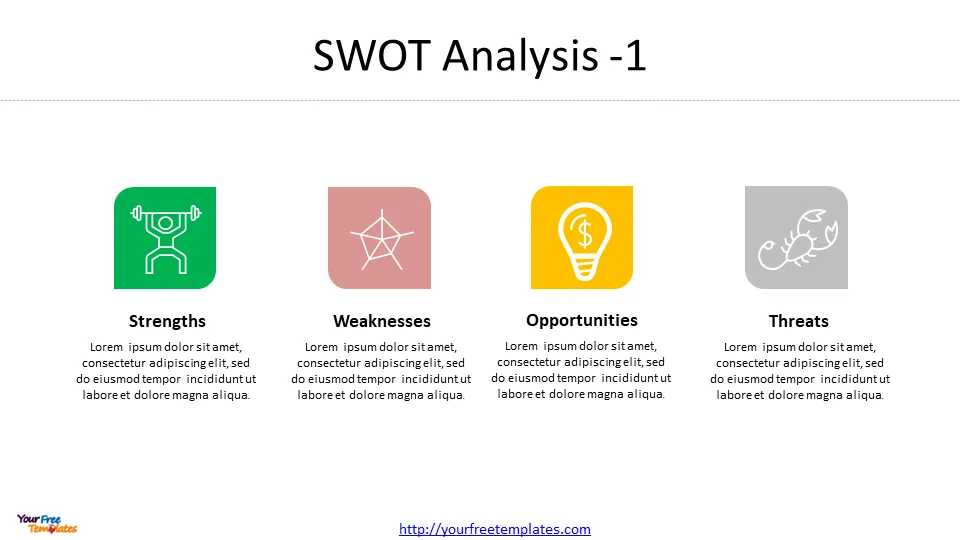
What is a SWOT Analysis?
Definition
SWOT analysis is a strategic planning framework used to evaluate an organization’s competitive position and develop strategic plans [1]. The acronym SWOT stands for Strengths, Weaknesses, Opportunities, and Threats [2]. This powerful tool helps businesses assess both internal and external factors that can impact their success [3].
Developed in the 1960s and 1970s by Albert Humphrey at the Stanford Research Institute, SWOT analysis was initially based on data from Fortune 500 companies [4]. Since then, it has been adopted by organizations of all types as an aid to making business decisions [4].
Purpose
The primary goal of a SWOT analysis is to increase awareness of the factors that go into making business decisions or establishing strategies [4]. It provides a clear understanding of a company’s current business situation by examining both internal and external elements [5].
A SWOT analysis helps organizations:
- Build on strengths
- Minimize weaknesses
- Seize opportunities
- Counteract threats [3]
This framework can be applied to various scenarios, including:
- Creating or updating business plans
- Deciding whether to introduce new products or services
- Conducting regular strategic planning reviews [3]
Components
A SWOT analysis consists of four key components:
- Strengths: These are internal attributes and resources that give an organization an advantage over its competitors. Examples include a diverse product line, loyal customers, or strong customer service [4] [5].
- Weaknesses: Internal factors that put a company at a disadvantage, such as a weak brand, excessive debt, or inadequate staffing [4] [5].
- Opportunities: External factors that an organization can capitalize on, like favorable export tariffs, tax incentives, or new enabling technologies [4] [5].
- Threats: External factors that could jeopardize an entity’s success, including increasing competition, weakening demand, or an uncertain supply chain [4] [5].
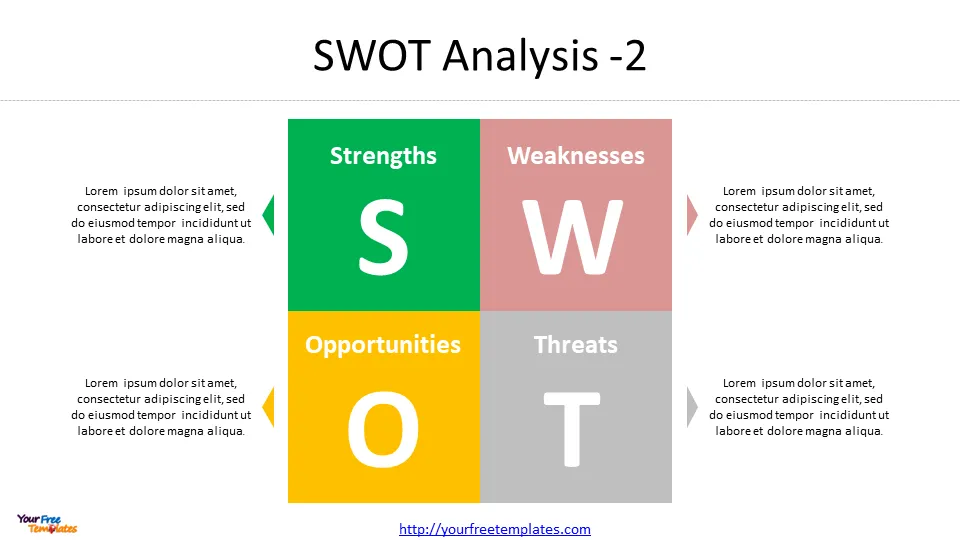
To conduct a SWOT analysis, businesses must examine both internally and externally focused activities [3]. Internal factors are generally under the company’s control and include areas such as operations, marketing, financial management, and human resources. External factors, on the other hand, are outside the company’s control and encompass elements like supplier operations, competitors, politics, and global trade [3].
While SWOT analysis is a valuable tool, it’s important to note its limitations. It does not prioritize issues, provide solutions, or help choose the best course of action. Instead, it generates a list of relevant issues that must be reviewed and analyzed to produce meaningful results [3].
By using SWOT analysis in conjunction with other assessment frameworks like PESTEL and Porter’s 5-Forces, businesses can gain a comprehensive understanding of their position in the marketplace and make informed decisions to drive growth and success [2] [5].
Conducting an Internal Analysis
Conducting an internal analysis is a crucial step in the SWOT assessment process. It involves evaluating the organization’s internal factors, including its resources and experiences, to identify strengths and weaknesses. This analysis provides valuable insights into the company’s current position and helps inform strategic decision-making.
Identifying Strengths
Strengths are internal attributes and resources that give an organization an advantage over its competitors. When identifying strengths, it’s important to consider various aspects of the business:
- Human Resources: Evaluate the skills, expertise, and capabilities of staff, volunteers, board members, and the target population [6].
- Physical Resources: Assess the company’s location, building, and equipment [6].
- Financial Resources: Examine grants, funding agencies, and other sources of income [6].
- Activities and Processes: Analyze the programs run and systems employed by the organization [6].
- Past Experiences: Consider past successes, reputation in the community, and lessons learned [6].
When listing strengths, it’s essential to avoid being overly modest. If struggling to identify strengths, start by listing general characteristics of the organization, such as size or community connections [6]. Some of these characteristics may turn out to be strengths.
One notable example of a company with significant strengths is Tesla. Tesla has a strong position in the electric vehicle (EV) market due to its pioneering status and strong brand recognition. The company’s advanced battery technology allows for superior range in its vehicles, while its extensive Supercharger network provides a significant advantage in terms of charging infrastructure [1].
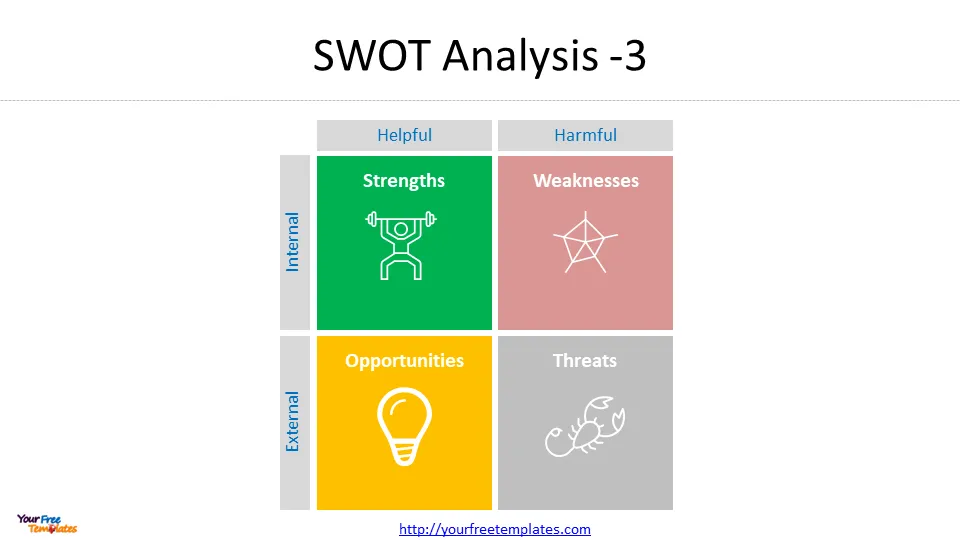
Recognizing Weaknesses
Weaknesses are internal factors that hinder an organization from performing at its optimum level. Identifying weaknesses requires courage and a dispassionate view of the company [7]. To conduct a thorough analysis of weaknesses:
- Create a “360” weakness inventory: Scrutinize every conceivable internal weakness of the business, rating them in terms of severity and considering potential solutions [7].
- Evaluate employee capabilities: Assess whether employees’ backgrounds align with their job functions and consider their training needs [7].
- Analyze departmental performance: Examine how well departments like customer service, accounting, and sales and marketing function independently and cooperatively [7].
- Compare products and services: Evaluate offerings against competitors to identify any gaps or shortcomings [7].
- Assess equipment and technology: Take stock of outdated or potentially obsolete equipment, especially in critical areas like computers and software [7].
- Consider intangible factors: Assess the company’s reputation by seeking candid feedback from trusted outsiders [7].
- Create a “catch-all” category: Include potential weaknesses that may not be immediately obvious, such as location or limited operating hours [7].
Using Tesla as an example again, some identified weaknesses include production capacity limitations, occasional quality control issues, and higher pricing compared to competitors, which may limit market penetration in price-sensitive regions [1].
By thoroughly examining both strengths and weaknesses, organizations can gain a comprehensive understanding of their internal capabilities and limitations. This knowledge forms a crucial foundation for developing effective strategies and making informed business decisions.
Evaluating External Factors
Evaluating external factors is a crucial step in the SWOT analysis process. It involves examining the opportunities and threats that exist outside of an organization’s control but can significantly impact its success. To conduct a thorough external analysis, organizations need to cast a wide net and consider various forces and facts that they do not control [6].
Spotting Opportunities
Opportunities are favorable external factors that could give an organization a competitive advantage [1]. To identify opportunities, organizations should consider the following:
- Future trends in their field or culture
- Economic conditions – local, national, or international
- Funding sources – foundations, donors, legislatures
- Demographic changes in the target population or area
- Physical environment factors (e.g., location, transportation)
- Legislative changes
- Local, national, or international events [6]
When spotting opportunities, it’s helpful to ask questions such as:
- What trends are evident in the marketplace?
- What demographics are we not targeting?
- What resources can we use to improve weaknesses?
- Are there market gaps in our services?
- What are our business goals for the year? [1] [8]
For example, Tesla has identified several opportunities in the electric vehicle (EV) market. The company stands to benefit from the growing global demand for EVs and has the potential to expand beyond automotive into related fields such as energy storage and solar power, leveraging its battery expertise. Additionally, the development of autonomous driving technology presents another significant growth avenue for Tesla [1].

Assessing Threats
Threats are external factors that have the potential to harm an organization [1]. These factors are often beyond the organization’s control but can significantly impact its operations and success. Common threats include:
- Increasing competition
- Changes in the industry
- New market trends
- Rising costs for materials
- Tight labor supply
- Supply chain disruptions
- Economic downturns [1] [6]
To identify threats, organizations should ask themselves:
- How many competitors exist, and what is their market share?
- Are there new regulations that could potentially harm our operations or products?
- What changes in the industry are cause for concern?
- Where are our competitors outperforming us? [1] [8]
Using Tesla as an example again, the company faces several threats. The competitive landscape for electric vehicles is intensifying as traditional automakers and new entrants invest heavily in EV technology. This increased competition could erode Tesla’s market share and profit margins. Economic factors such as downturns could impact sales of Tesla’s primarily luxury-oriented vehicles. The company also faces risks related to supply chain disruptions, particularly for critical materials used in battery production [1].
To effectively evaluate external factors, organizations should encourage open discussion and brainstorming among staff members, volunteers, and stakeholders. It’s important to remember that one individual may have information about an opportunity or threat that is essential to understanding the organization’s position and determining its future [6].
By thoroughly assessing both opportunities and threats, organizations can gain a comprehensive understanding of their external environment. This knowledge is crucial for developing effective strategies and making informed business decisions that capitalize on opportunities while mitigating potential threats.
Creating Your SWOT Matrix
Matrix Structure
A SWOT matrix is typically presented as a square divided into four quadrants, each dedicated to an element of SWOT: Strengths, Weaknesses, Opportunities, and Threats [1]. This visual arrangement provides a quick overview of an organization’s position. The matrix is often structured with internal factors (Strengths and Weaknesses) on the top row and external factors (Opportunities and Threats) on the bottom row. Additionally, the left side of the table usually contains more positive or favorable aspects, while the right side includes more concerning or negative elements [1].
To create a SWOT matrix, one can start with a simple table with two rows and two columns. Strengths should be placed in the top left quadrant, Weaknesses in the top right, Opportunities in the bottom left, and Threats in the bottom right [9]. This layout allows for easy comparison and analysis of the different factors affecting the organization.
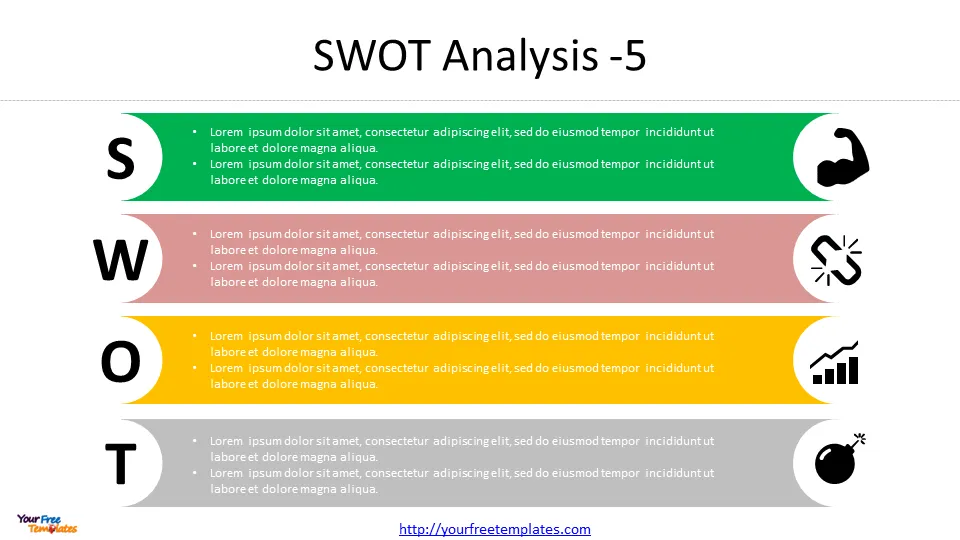
Tips for Effective Visualization
To make the SWOT analysis visually appealing and easy to understand, consider the following tips:
- Keep it concise: Don’t create an exhaustive list. Instead, focus on high-level, important factors to maintain clarity and impact [10].
- Use data to support reasoning: Avoid subjectivity by backing up each statement with detailed evidence and analysis. Include data, examples, and even contradictory evidence to make the SWOT analysis more compelling [11].
- Prioritize findings: A good SWOT analysis is brief and to the point. Highlight only the key strengths, weaknesses, opportunities, and threats that are most relevant to strategic decision-making. Prioritize strengths and weaknesses by impact, and opportunities and threats by both impact and likelihood [11].
- Incorporate visual elements: Use colors, icons, or other visual cues to differentiate between the four quadrants and make the matrix more engaging.
- Consider using templates: If creating an attractive report seems daunting, utilize pre-designed SWOT analysis templates as a starting point [9].
- Balance your time: Devote equal attention to each of the four elements (S, W, O, and T) to ensure a comprehensive analysis [10].
- Gather diverse perspectives: Include input from a wide range of people within the company, including team members who focus on both internal and external factors. It can also be helpful to get views from someone external to the organization [10].
- Prepare thoroughly: Before creating the matrix, ensure you’ve spoken to customers and employees about the company to gather comprehensive insights [10].
- Use the matrix as a starting point: Remember that the SWOT analysis is not an end in itself but a tool to facilitate strategic planning. After creating the matrix, develop strategies to address the prioritized issues by asking questions such as:
- How can we use our strengths to take advantage of the identified opportunities?
- How can we use these strengths to overcome the identified threats?
- What do we need to do to overcome the identified weaknesses in order to take advantage of the opportunities?
- How will we minimize our weaknesses to overcome the identified threats? [9]
By following these guidelines, organizations can create a visually effective and strategically valuable SWOT matrix that serves as a powerful tool for decision-making and strategic planning.
Turning SWOT Insights into Action
After conducting a SWOT analysis, it’s crucial to transform the insights gained into actionable strategies. This process involves leveraging strengths, addressing weaknesses, capitalizing on opportunities, and mitigating threats. By doing so, organizations can enhance their competitive position and drive growth.

Leveraging Strengths
Strengths are internal attributes that give an organization an advantage over its competitors [4]. To leverage these strengths effectively:
- Identify core competencies: Recognize what the organization excels at, such as a strong brand, loyal customer base, or unique technology [4].
- Align strengths with opportunities: Use existing strengths to capitalize on market opportunities or counteract potential threats [12].
- Create a unique selling proposition: Leverage competitive pricing or other strengths as a differentiator in the market [12].
Addressing Weaknesses
Weaknesses are internal factors that hinder an organization from performing at its optimum level [4]. To address these weaknesses:
- Openly identify areas of improvement: Recognize and acknowledge weaknesses without bias [12].
- Prioritize weaknesses: Focus on addressing the most critical weaknesses that impact productivity, revenue streams, or competitive edge [2].
- Develop improvement strategies: Create comprehensive plans to enhance weak areas, potentially involving training, process improvements, or resource allocation [2].
- Foster creativity: Encourage team members to brainstorm innovative solutions to address identified weaknesses [12].
Capitalizing on Opportunities
Opportunities are favorable external factors that could give an organization a competitive advantage [4]. To capitalize on these opportunities:
- Align with market trends: Identify and leverage positive trends in the marketplace [4].
- Explore new markets: Consider expanding into untapped demographics or geographic areas [4].
- Innovate: Develop new products or services that address emerging market needs [4].
- Leverage technology: Adopt new technologies that can improve efficiency or create new business models [4].
Mitigating Threats
Threats are external factors that have the potential to harm an organization [4]. To mitigate these threats:
- Conduct regular environmental scans: Stay informed about industry changes, competitive landscape, and macroeconomic factors [4].
- Develop contingency plans: Prepare strategies to address potential threats, such as increased competition or economic downturns [4].
- Diversify: Reduce reliance on single markets, products, or suppliers to minimize risk [4].
- Strengthen competitive position: Use insights from the SWOT analysis to enhance the organization’s overall market position [12].
To effectively turn SWOT insights into action, organizations should:
- Prioritize findings: Focus on the most impactful strengths, weaknesses, opportunities, and threats [12].
- Set measurable goals: Establish clear, tangible objectives for each action item [2].
- Assign responsibilities: Delegate management of each action item to specific team members [2].
- Create timelines: Develop realistic timelines for implementation and set benchmarks to track progress [2].
- Regularly update the analysis: Conduct SWOT analyzes periodically to reflect recent changes in the business environment [12].
By following these steps, organizations can transform their SWOT analysis from a static document into a dynamic tool for strategic planning and continuous improvement.
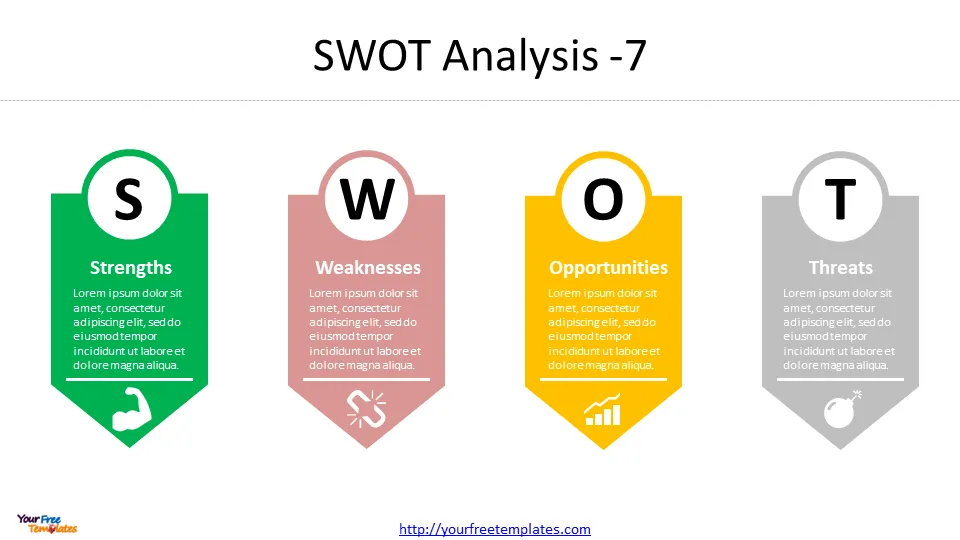
SWOT Analysis Examples
Business Example
To illustrate the practical application of a SWOT analysis, let’s consider a hypothetical family-owned restaurant operating in an urban area with a single location [13]. This example demonstrates how SWOT analysis can be applied to an entire organization or a specific project within a department [13].
The restaurant’s SWOT matrix might look like this:
| Strengths | Weaknesses |
|---|---|
| – Prime location | – Limited purchasing power |
| – Strong reputation | – Modest advertising budget |
| – Popular seasonal menu | – Limited reach |
| – Not leveraging food delivery apps |
| Opportunities | Threats |
|---|---|
| – Increasing consumer demand for locally sourced ingredients | – Competition from chain restaurants |
| – Potential for online ordering and delivery | – Economic uncertainty |
| – Changing consumer preferences |
This matrix format allows for quick and easy identification of various elements in the analysis [13]. By examining each quadrant, the restaurant can develop strategies to leverage its strengths, address weaknesses, capitalize on opportunities, and mitigate threats.
For instance, the restaurant could continue to experiment with its popular seasonal menu and nurture relationships with regular customers to maintain its strong reputation [13]. To address weaknesses, the business might consider investing in technical expertise to take advantage of food delivery apps, potentially increasing its reach and sales [13].
The opportunity presented by increasing consumer demand for ethically produced, locally grown ingredients could be capitalized on by sourcing more local produce, which might also help reduce costs [13]. However, threats such as competition from chain restaurants and economic uncertainty remain challenging to mitigate fully, requiring ongoing monitoring and strategic planning [13].
Personal SWOT Analysis
A personal SWOT analysis is a powerful self-evaluation exercise that can be applied to various aspects of an individual’s life, from career development to personal growth [14]. It provides structure to self-reflection and focuses on both positive and negative aspects, helping to create a balanced view of one’s current situation and future potential [14].
To conduct a personal SWOT analysis, individuals should consider the following areas:
- Strengths: Identify personal successes, qualifications, skills, and positive traits [14].
- Weaknesses: Honestly assess areas for improvement, being careful not to dwell on negatives but to understand them for future growth [14].
- Opportunities: Consider potential avenues for advancement in work, education, or personal life [14].
- Threats: Recognize barriers or obstacles that may hinder achieving goals and dreams [14].
A personal SWOT analysis can be particularly useful before job interviews, during self-evaluations, or when planning career moves [15]. It helps individuals understand where they stand and what they want to achieve in life [15].
When conducting a personal SWOT analysis, it’s important to be brutally honest and avoid personal biases [15]. The process can be as detailed or as brief as needed, depending on the individual’s goals. Some may spend hours creating exhaustive lists, while others might prefer a quick, gut-instinct approach [14].
By systematically analyzing personal strengths, weaknesses, opportunities, and threats, individuals can gain valuable insights into their current position and develop strategies for personal and professional growth. This structured approach to self-evaluation can lead to more informed decision-making and targeted self-improvement efforts.

Conclusion
SWOT analysis has a significant influence on strategic planning and decision-making in organizations of all sizes. By providing a structured approach to evaluate internal strengths and weaknesses alongside external opportunities and threats, it allows businesses to gain a comprehensive understanding of their position in the market. This insight enables companies to develop strategies that capitalize on their strengths, address weaknesses, seize opportunities, and mitigate potential threats.
The versatility of SWOT analysis makes it a valuable tool to use in various scenarios, from business planning to personal development. Whether applied to an entire organization, a specific project, or an individual’s career path, SWOT analysis offers a framework to analyze current situations and plan for the future. By turning SWOT insights into action, businesses and individuals can make informed decisions, set realistic goals, and develop strategies to achieve success in their respective fields.
FAQs
1. What are the steps involved in conducting a SWOT analysis?
To perform a SWOT analysis effectively, follow these five steps:
- Form a team and set a clear objective.
- Collect internal and external resources.
- Extract relevant information and gather ideas.
- Organize your findings into a SWOT matrix.
- Analyze the results and formulate a strategy.
2. Can you explain what a SWOT analysis is and provide some examples?
A SWOT analysis is a strategic planning tool used to identify and assess strengths, weaknesses, opportunities, and threats related to business competition or project planning. This method is utilized by various organizations, including small businesses, non-profits, and large corporations, and can also be adapted for personal use.
3. What are the five key elements of a SWOT analysis?
SWOT analysis consists of five main aspects: Strengths, Weaknesses, Opportunities, Threats, and the overall assessment. This framework helps in recognizing an organization’s internal strengths and weaknesses, as well as external opportunities and threats, thereby facilitating strategic planning and decision-making.
4. What constitutes the four components of a SWOT analysis?
The four components of a SWOT analysis are:
- Strengths: attributes of the organization that are helpful to achieving the objective.
- Weaknesses: attributes of the organization that are harmful to achieving the objective.
- Opportunities: external conditions that are helpful to achieving the objective.
- Threats: external conditions that are harmful to achieving the objective.
This structure supports businesses across various industries in their strategic planning processes.
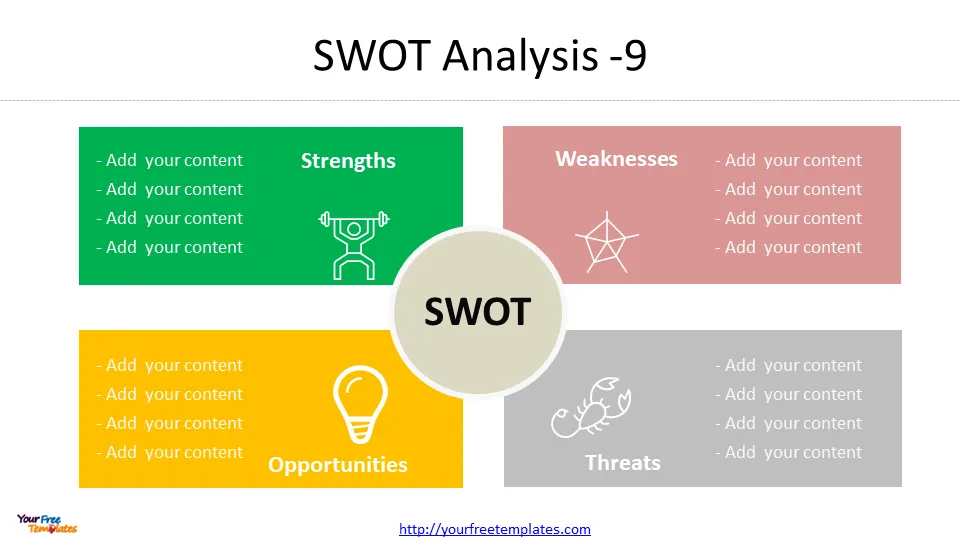
Size:234K
Type: PPTX
Aspect Ratio: Standard 4:3
Click the blue button to download it.
Download the 4:3 Template
Aspect Ratio: Widescreen 16:9
Click the green button to download it.
Download the 16:9 Template
References
[1] – https://www.investopedia.com/terms/s/swot.asp
[2] – https://corporatefinanceinstitute.com/resources/management/swot-analysis/
[3] – https://www.business.qld.gov.au/running-business/planning/swot-analysis
[4] – https://www.techtarget.com/searchcio/definition/SWOT-analysis-strengths-weaknesses-opportunities-and-threats-analysis
[5] – https://web.inbound281.com/blog/the-four-parts-of-a-swot-analysis
[6] – https://ctb.ku.edu/en/table-of-contents/assessment/assessing-community-needs-and-resources/swot-analysis/main
[7] – https://smallbusiness.chron.com/identify-swot-weakness-48695.html
[8] – https://asana.com/resources/swot-analysis
[9] – https://piktochart.com/blog/swot-analysis-guide/
[10] – https://getlucidity.com/strategy-resources/ultimate-guide-to-swot-analysis/
[11] – https://www.stratnavapp.com/Articles/better-SWOT
[12] – https://medium.com/@jhagg0748/an-introduction-to-a-swot-analysis-228d15ee4ce1
[13] – https://www.wordstream.com/blog/ws/2017/12/20/swot-analysis
[14] – https://slidemodel.com/personal-swot-analysis-quick-guide/?srsltid=AfmBOopQIAXdtEulXkeZbaxbZeZbimbDbEytDG43PDgHGI_hAqeT67-_
[15] – https://www.twine.net/blog/personal-swot-analysi/













